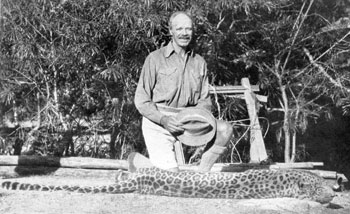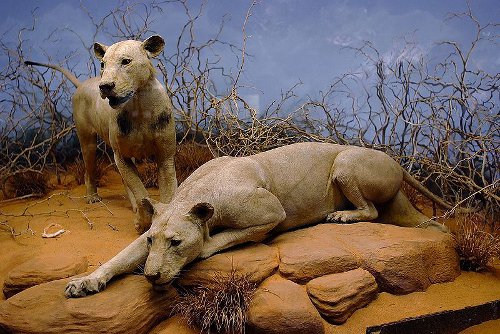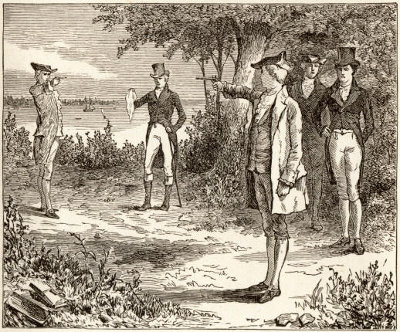
Editor’s Note: This is a guest post from Ty Karnitz.
What separates man from beast?
It is a question I’ve heard answered a dozen ways: religion, tool-making, empathy, agriculture, self-awareness.
The real answer is much simpler. The only thing that separates man from beast is a wall. And that only works most of the time.
I once believed mankind had no natural predators. I was wrong. The threat of being eaten sounds ridiculous, but for as long as mankind has existed it has been hunted. Leopards, tigers, and lions all consider primates a natural food source, and any man found too far from home at dusk is an easy meal.
Many cats have attacked man in the past and a few became dedicated man-eaters. This is their legacy.
Historic Man-Eaters
In Asia
History’s most prolific man-eaters stalked Northern India during the early 20th century. One man, big-game hunter and author Jim Corbett, hunted down 33 man-eaters responsible for well over 1,000 deaths. The following are his most well known.
Leopard of Rudraprayag

Jim Corbett with the Leopard of Rudraprayag, which killed 250 people and measured 7’10”.
It’s believed the Leopard of Rudraprayag turned to man-eating after the 1918 flu pandemic that caused millions of deaths in India. So many died that the normal rites of cremation weren’t performed and the plague’s victims were left in shallow, mass graves or even unburied. Scavenging from the corpses, the leopard learned man was an easy meal.
Roaming the Uttarkhan area of Northern India for 8 years, the leopard terrified villages. In the middle of the night, his victims would wake to find the cat clawing through their thatched mud walls to drag them from their beds.
By 1926 alone, the leopard was responsible for killing 250 people. That same year, Jim Corbett shot and killed the leopard, which measured 7’10” at its death.
Panar Leopard
While not as famous as the Leopard of Rudraprayag because it hunted a more secluded area of India and didn’t catch the attention of journalists, the Panar Leopard was still feared and hated in the Northern part of India’s Kumaon District.
After a poacher shot him, the Panar Leopard turned to man-eating and killed over 400 people before Jim Corbett killed it in 1910.
Champawat Tiger
This female Bengal tiger known as the Champawat Tiger began her man-eating in Nepal. There, she killed an estimated 200 people before the Nepalese army was called in to hunt her down. Though the army failed to kill the man-eater, they did succeed in scaring her across the River Serda and into India.
Once in India, the tigress continued her man-eating ways and claimed a further 236 victims. Her final victim, a 16-year-old girl, was killed just hours before Jim Corbett hunted her down in 1907.
In Africa
The Dark Continent and the Cradle of Life; Africa is both. She is known for her rugged beauty and for her riches — gold, diamonds, and ivory. She calls to man’s sense of adventure and is the land where men have sought to challenge themselves. Of all the places that humble men, perhaps none does it as thorough as she. Africa is home to elephants, rhinos, buffalo, and of course, the king of the jungle.
Tsavo Man-Eaters

The Ghost and the Darkness, responsible for killing over 100 people, are now on display in the Chicago Field Museum of Natural History.
No article about man-eaters is complete without mentioning The Ghost and the Darkness, the two most infamous man-eating lions of all time. Their exploits were logged in Col. John Henry Patterson’s 1907 book The Man-Eaters of Tsavo.
In his book, Col. Patterson recounts his epic hunt for two mane-less lions whose predation halted the British Empire’s construction of the Kenya-Uganda Railroad. Between March and December of 1898, The Ghost and the Darkness killed more than a 100 people. In the middle of the night, they’d drag a victim from his tent and feast while his fellows listened to the lions consume him, powerless to do anything.
The lions’ ability to avoid Patterson gave rise not only to their nicknames but also their legend. The workers knew the lions were evil spirits sent to kill them, and soon abandoned their posts.
After much trial and error, Col. Patterson did succeed in killing both lions. After 25 years as rugs on Patterson’s floor, the lions were sold to the Chicago Field Museum of Natural History where they were restored and mounted and remain on display to this day.
Man-Eaters of Njombe
Between 1932 and 1947 an entire pride of 15 lions turned to man-eating in Southern Tanzania. George Rushby, the game warden who eliminated the pride, considers the Tsavo lions small game compared to those of Njombe.
Ignoring personal bias, Rushby might be right. During their fifteen-year reign, the lions worked together and developed a relay system to safely drag their victims into the bush. They ended up claiming the lives of some 1,500-2,000 people.
Legend says the lions were not normal lions but animals under the spell of a spiteful witch doctor named Matamula Mangera who unleashed them upon the locals after he lost his job as Headman of the Iyayi village.
As the lions harassed the villagers, they begged the local chief to restore Matamula to his post but the chief refused and the killing continued.
It was only after Matamula was restored to power that George Rushby succeeded in killing the lions.
Causes of Man-Eating
But what creates a man-eater? Why did these cats kill so many people? Is there something hard-wired in their brain that turns them into killers? Is it just chance? Or is there something else?
Scientists have theorized for decades the possible causes of man-eating.
One of the most prevalent theories is that man-eating is not natural and big cats prey on humans when they’re too old or lame to hunt their normal food sources. In other words, humans are easier to catch than deer.
Many man-eaters do prove to be old and lame; however, this theory doesn’t explain why healthy cats turn their golden eyes our way. So what are the other possible explanations? Some biologists have pointed out that man-eating often occurs when a cat’s natural food source is missing, and eventually these cats get hungry enough that anything and anyone is food. This theory has been used to explain the Lions of Njombe.
When Europeans colonized Africa they brought with them the disease rinderpest. Rinderpest, also known as cattle plague, is closely related to measles, and is known for its high mortality rate. In the 1800s, the disease killed an estimated 90% of domestic cattle in Africa. But rinderpest also infects buffalo, antelope, deer, giraffe, wildebeests, and warthogs, all creatures considered part of a normal lion’s diet. The veterinary scientist responsible for creating the rinderpest vaccine, Walter Plowright, estimated in 1982 that up to 90% of Kenya’s wild buffalo were killed by the disease in the 1800s.
One outbreak of rinderpest threatened the livestock around Njombe and the government decided that the best way to keep the outbreak from spreading was to cull the animals that could carry the disease. Doing so eliminated a large portion of available prey. To supplement their diet, the lions ate humans instead.
Another theory why some cats turn away from natural food sources is that they are trained to do so through human catastrophe. Big cats are not opposed to scavenging; it is this act that some believe leads to man-eating. Man-eating cats appear after catastrophes that leave behind human corpses to be scavenged on. The Panar Leopard appeared after a cholera outbreak and the Leopard of Rudraprayag after the 1918 influenza epidemic.
Another example of this is from Africa, where Arab slavers once crossed the Kenyan wilderness with their victims in tow. Those not strong enough to survive the journey were left dead or dying in the slave caravan’s wake. Sometimes, the slavers tied men to trees and left them for the lions. The poor souls became a lion’s meal and taught the cats humans were food.
Like most mammals, a lion learns from his mother. When a lioness shows her cub that humans are an easy meal by scavenging from corpses, it reinforces the habit of man-eating, a habit that will continue into adulthood. Once the slave trade stopped, the lions in the region did not stop eating people, they simply replaced the dead with the living. Learning man-eating from the mother is not exclusive to lions, either. The Tigers of Chowgarh, a pair of Bengal tigers that hunted the Kumaon district of India, were a mother tigress and her sub-adult cub. Over the course of five years they killed an estimated 64 people. Many reports mention that the earlier attacks were performed by a single tiger, the mother, and the later attacks included both mother and son. Jim Corbett, who dispatched both animals, concluded that the tigress’ canine was broken, an injury which turned her away from normal prey sources. To feed her cub, she ate people and in the process trained her cub to do the same.
As sound as these theories are, they rest on the principle that big cats do not look at humans as natural prey, and that might be a huge misconception. Our egos find it almost impossible to admit we are a natural food source for lions, tigers, leopards, and jaguars. However, much scientific evidence suggests we are just that and have always been so. Both tigers and jaguars eat primates as a part of a normal diet, and lions even hunt chimpanzees, our closest known relative. The fossil evidence puts the predation rate of early hominids between 6 and 10 percent. Early hominids were small, between 3ft and 5ft and lived in an environment with ten times the number of predators, including the saber-tooth cat. Predation wasn’t the exception, but the rule. Some scientists believe this predation forced early ape-men to band together and fight back.
Our violent reaction to threatening animals has eliminated many potentially dangerous animals, but it doesn’t prevent predation it just punishes it. If cases of man-eating have declined throughout our history, it may be only because big cats have learned that preying on humans is dangerous.
Modern Man-Eaters
The world may never again see man-eaters as prolific as those of the early 20th century but that doesn’t mean man is safe when he ventures into the wild. Hunter and author Peter Hathaway Capstick mentions in his book, Death in the Silent Places, that he believes that in the past 400 years tigers have killed almost a million people — that’s an average of 2,500 people a year.
The tiger’s influence on life in India is far from historic. In the 1980s, about 60 woodcutters a year were falling prey to tigers in the Ganges Delta. A 1989 article in The New York Times mentions different methods used to prevent tiger attacks, including electrified scarecrows scented like humans. However, they found the most effective method for dissuading tiger attacks is a mask.
Officials in the region issued pale rubber masks to woodcutters who would wear them on the back of their heads. The tigers, thinking the woodcutters were watching them, stopped attacking. The article states that no woodcutter wearing a mask had been attacked in three years and that 29 people not wearing masks were killed in the previous 18 months. To this day, woodcutters and biologists alike wear masks on the back of their heads to discourage tiger attacks.

However, the tigers are learning, and in the Sundarbans region of India, tigers continue to attack between 50 and 250 people a year in that region alone. The tension between tigers and the people of the area has led to humans trying to fight back. The villagers have attacked back and a 2003 article from the BBC reported an instance where a village beat a Bengal tiger to death, claiming they had no choice after it had entered their village and harassed them and their livestock. More explanations for the tiger attacks have been put forth for the animals of the region, including that the primary drinking water for the tigers is salt water, which makes them uncomfortable and irritable.
The lion is not to be outdone by the tiger. Lions attack on average 550-750 people a year, and in the early 1990s a lion known as the man-eater of Mfuwe killed 6 people. The lion got hold of its last victim’s laundry bag and played with it for days before a California man on safari named Wayne Hosek took it upon himself to rid the village of the man-eater. Today, the man-eater of Mfuwe is found beside The Ghost and The Darkness.
More recently, a lion named Osama (after the terrorist) killed more than 50 people in Tanzania between 2002 and 2004. Osama was only 3.5 years old when he was killed, and experts believe he was part of a pride of lions preying on humans.
These cats should serve as a reminder that as manly as we may be, we are not always the top predator.
For further reading on man-eaters and the men who hunt them, read this article on The Lost Genre of Safari Stories and the books and articles listed in the resources section below.
_________
Resources
The Most Ferocious Man-Eating Lions by Abigail Tucker (Smithsonian.com)
Man-Eaters of Kumaon by Jim Corbett
Death in the Long Grass by Peter Hathaway Capstick
Death in the Silent Places by Peter Hathaway Capstick
Man-Eaters of Tsavo by Lt. Colonel J.H. Patterson
Ghosts of Tsavo: Stalking the Mystery Lions of East Africa by Philip Caputo
The Tiger by John Vaillant
The Book of Deadly Animals by Gordon Grice
Face Masks Fool the Bengal Tigers by Marlise Simons (New York Times)







